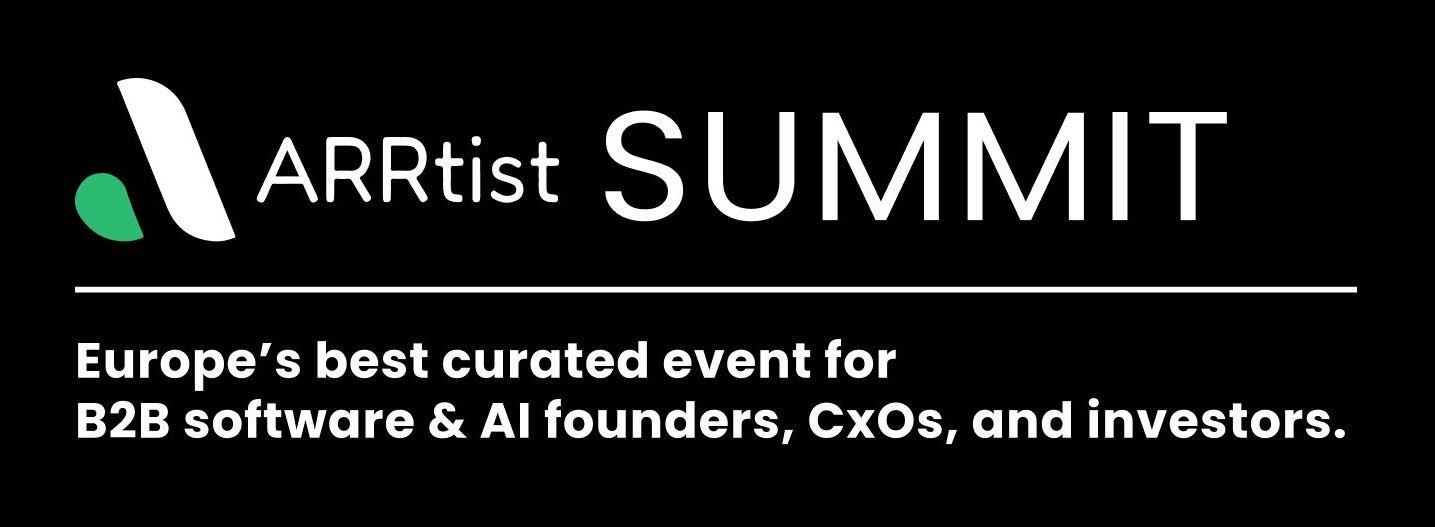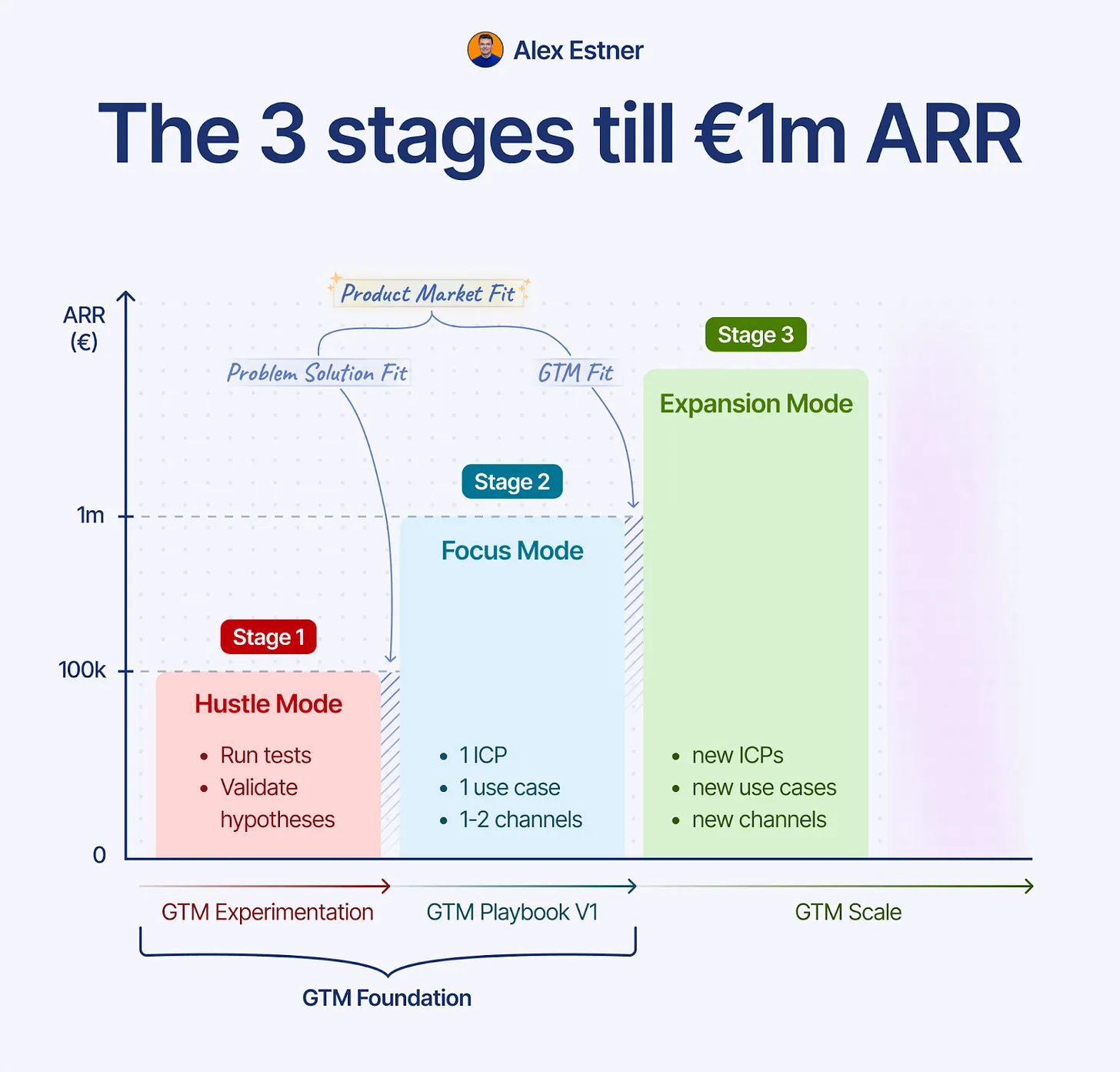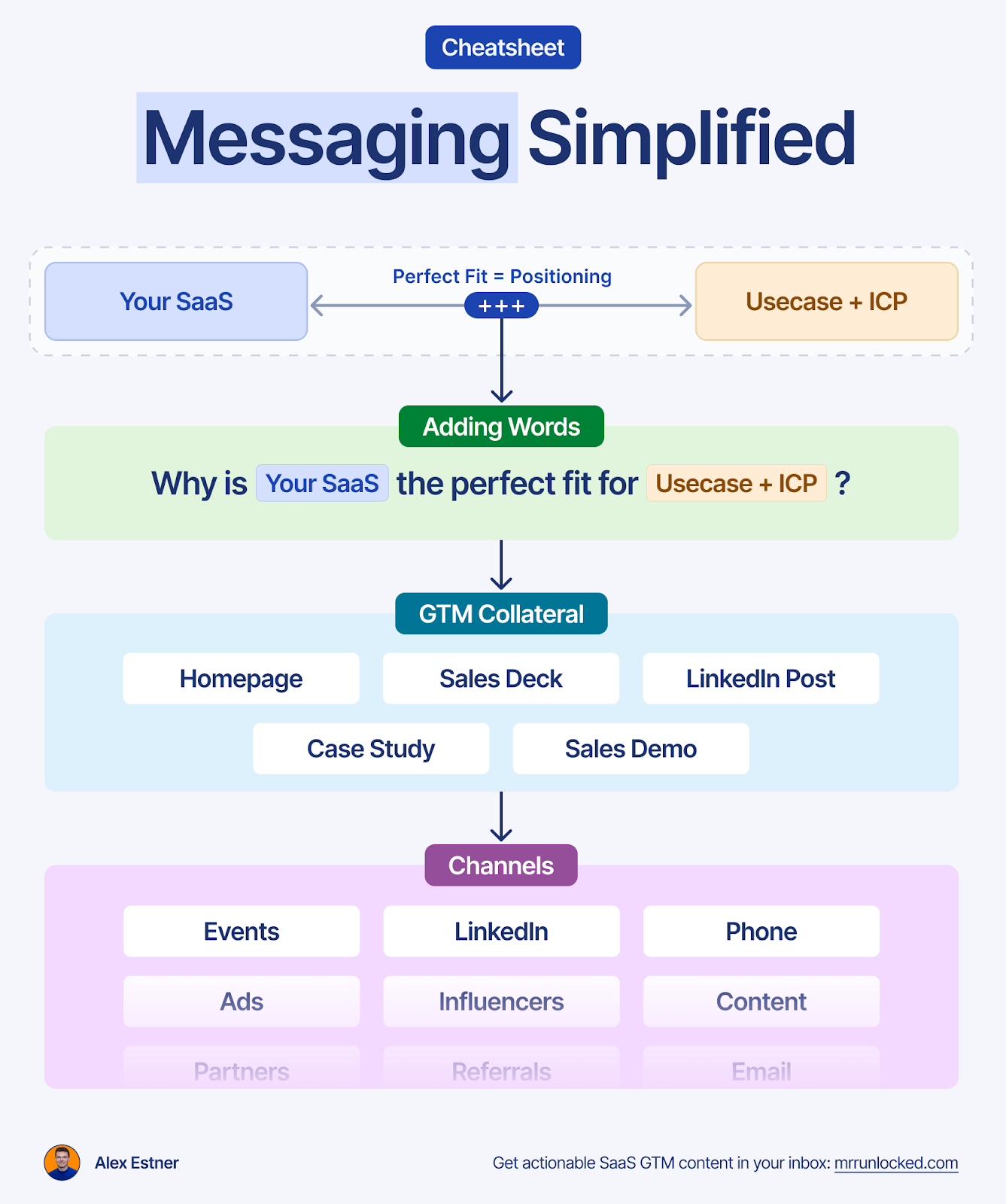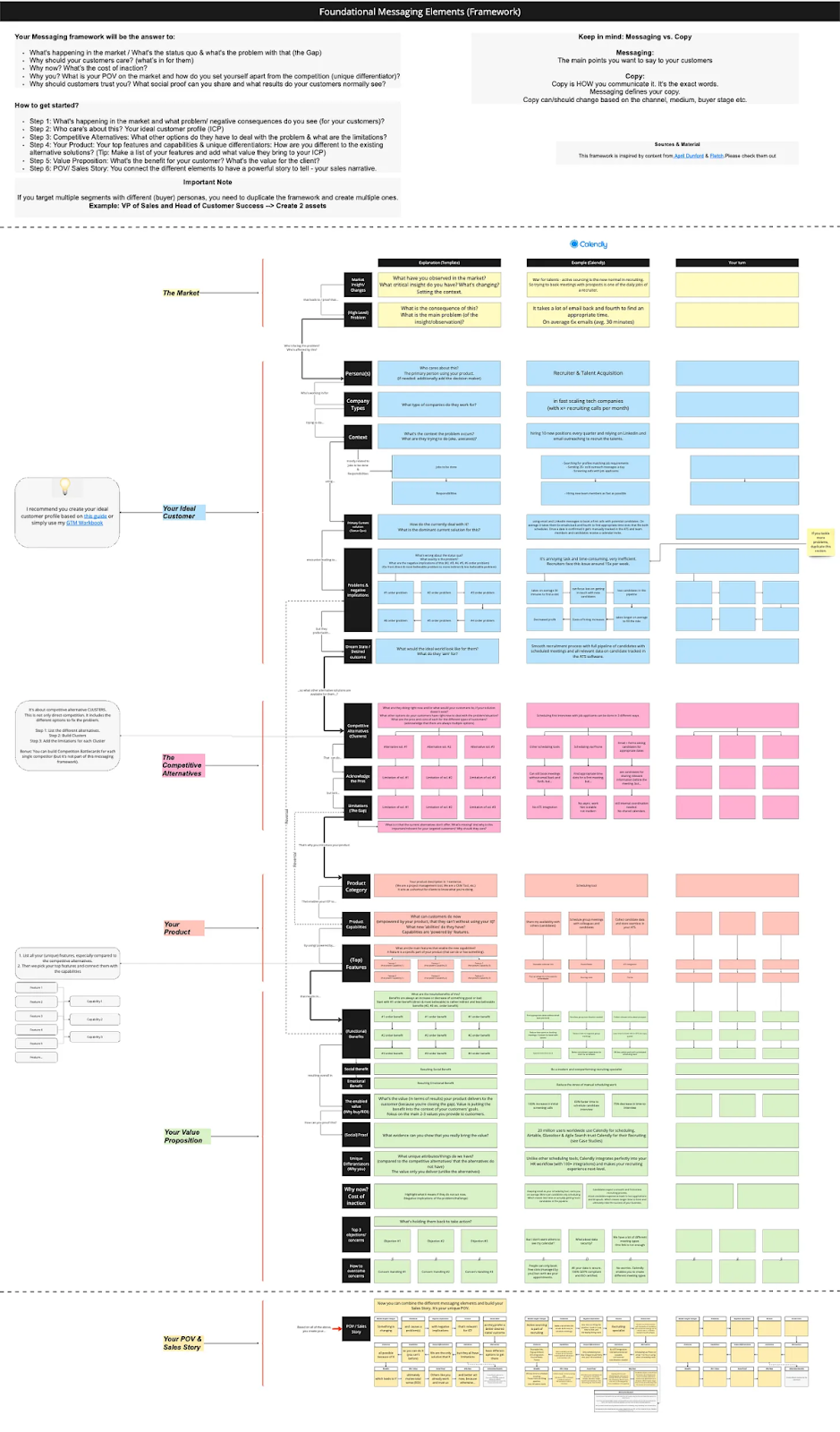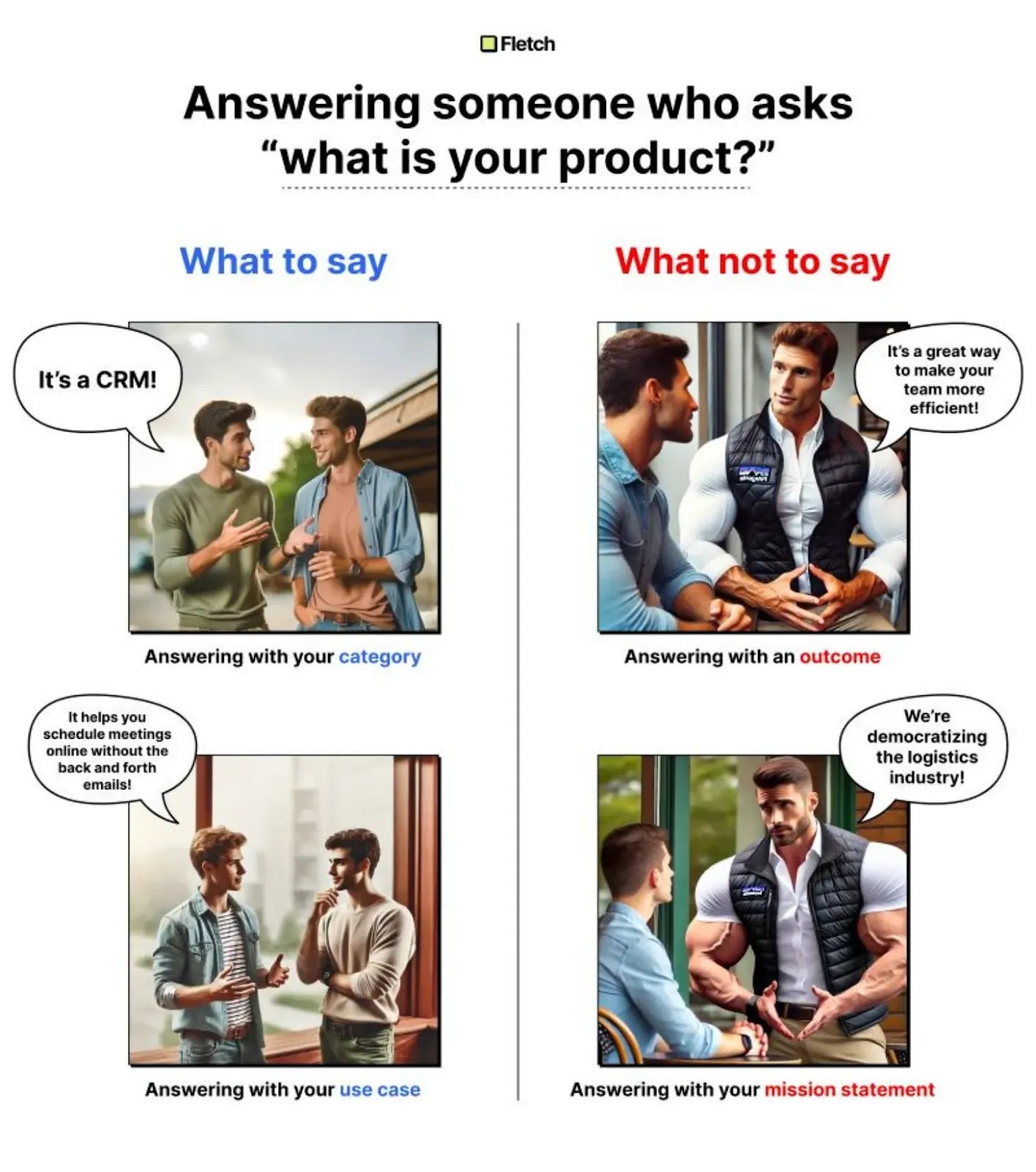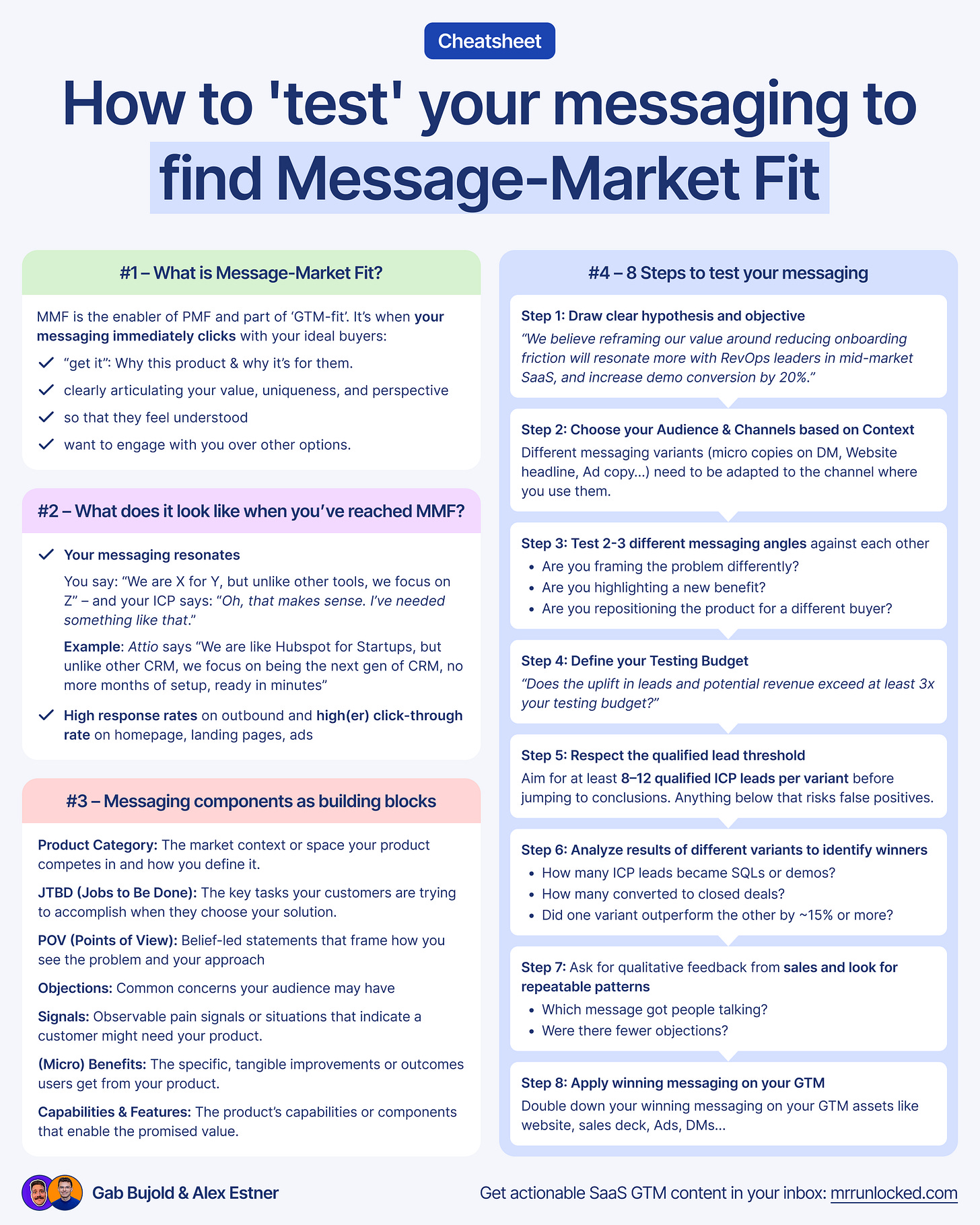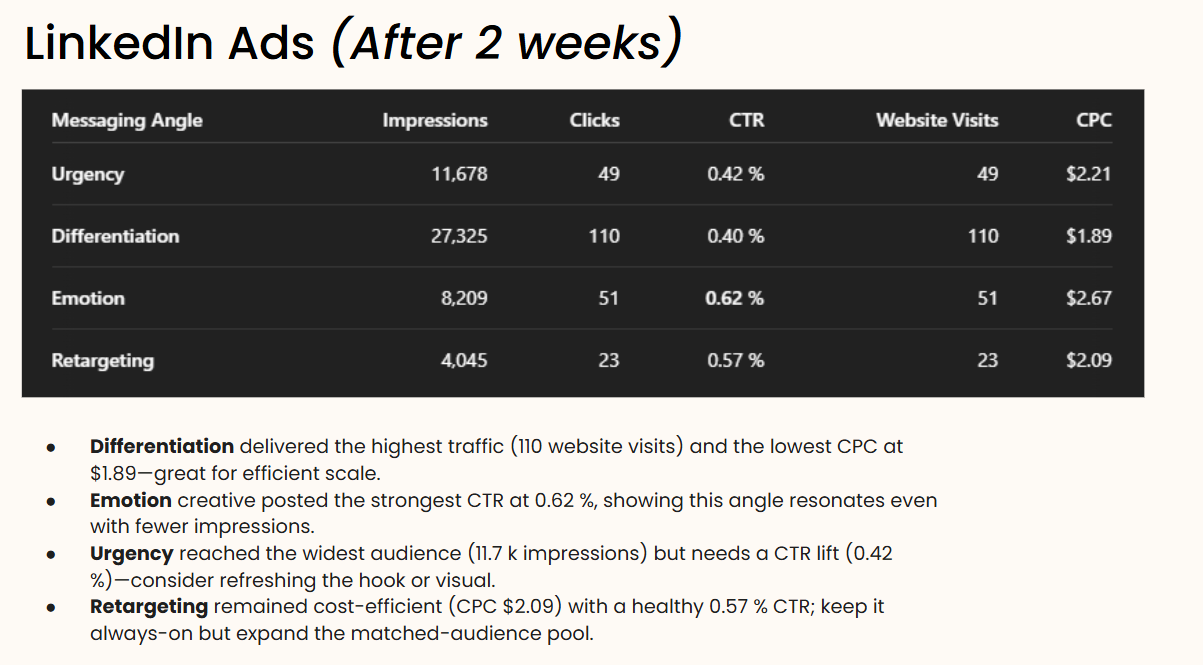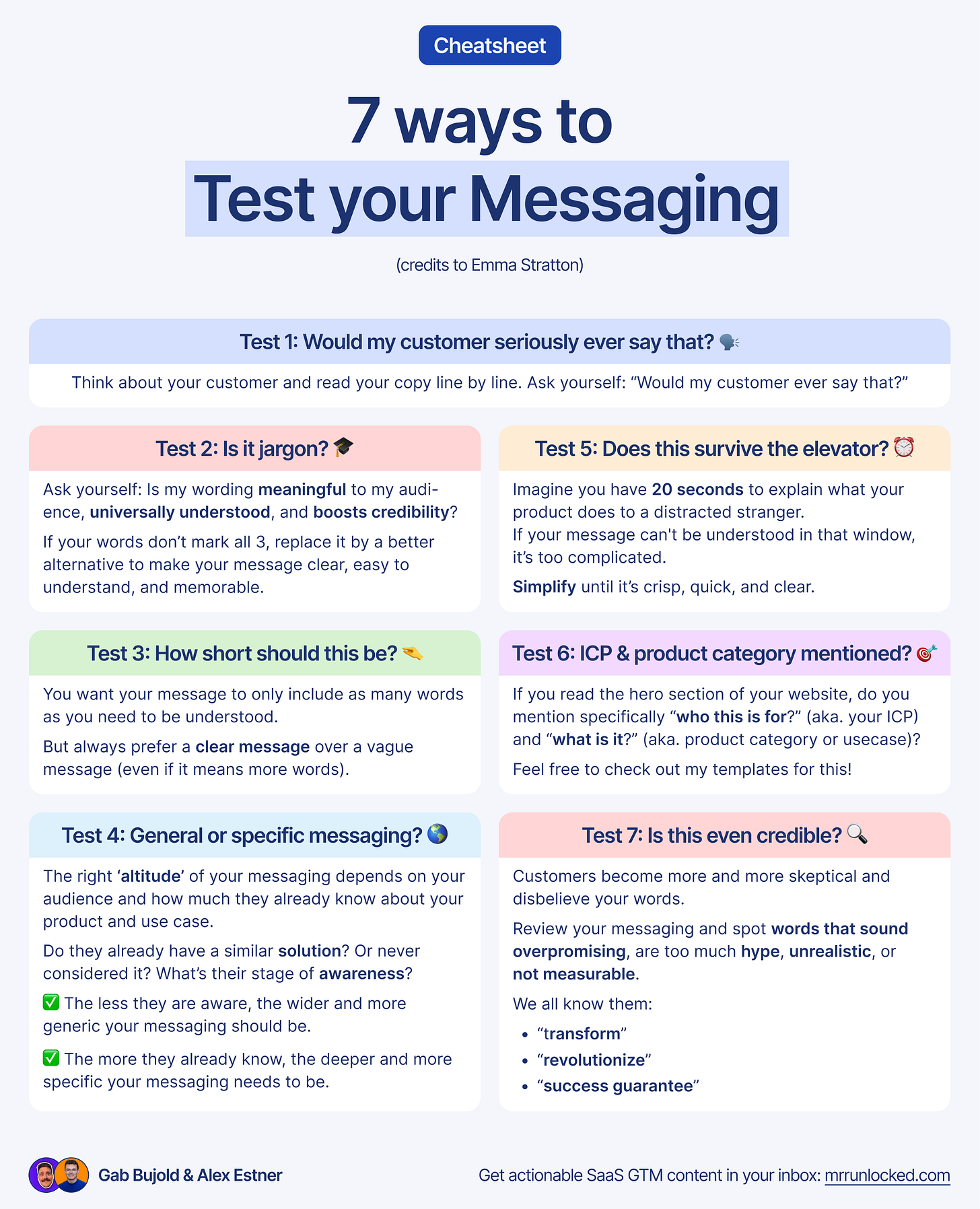How to 'test' your messaging to find Message-Market Fit
+ 7 actionable tactics to quickly test your messaging
Hey - it’s Alex, this time together with Gab Bujold!
Today, we cover how to test your messaging to find message-market fit and ultimately product-market fit.
Bonus Links
👉 Check out my GTM library with 50+ free resources and my vetted SaaS tools for early-stage SaaS startups
👉 Work 1-on-1 with me to build and execute your GTM foundation
In case you missed the last 3 episodes:
✅ 14 actionable tactics for a better CRM
✅ 10 GTM tactics to generate pipeline in H2 2025
✅ GTM foundation: How SaaS founders grow from €0 to €1 million ARR
A quick word from our sponsors
📢 Paddle - insight-packed sessions for SaaS growth & exit readiness.
Join Paddle’s exclusive five-part online live series designed for SaaS and digital product leaders who want to scale with precision.
From pricing strategies to exit planning, each session is packed with expert insights, real-world data, and proven strategies to help you grow smarter, not just faster.
📢 ARRtist Summit – The conference for B2B software & AI founders
Join ARRtist SUMMIT to meet 500 high-profile B2B software & AI founders and CxOs, and 125 B2B investors. Network with and learn from the most relevant European community in B2B software & AI.
Apply now for one of 500 founder/CxO tickets!
Use the code “MRR Unlocked” for exclusive discounted tickets.
Want to reach 5000+ early-stage SaaS founders/leaders? Sponsor the next newsletter.
Note: This episode might be too long for your email client. Read the full episode on web.
Chasing product-market fit when you don’t even have messaging that resonates with your ICP is the wrong approach for many early-stage startups.
By skipping messaging validation, you’ll end up paying for it in churn, CAC, and missed sales later.
In this episode, we’ll cover:
What is Messaging and Message-Market-Fit
How to build your messaging
How to test your messaging
Rewriting your homepage every quarter, when you don’t have the right core messaging in place, won’t solve your problem. Why?
Because you're not iterating - you're guessing what could be relevant to your prospects.
Every single promotion, email, and communication to your prospects will always feel sub-optimal without knowing the performance of your messaging.
You can’t achieve repeatable revenue if you sound like everyone else in your market. Prospects need to know why they should choose you over others.
What is Message-Market Fit (MMF) and the Difference to Product Market Fit?
Product Market Fit (PMF) is the broader goal for most SaaS founders:
✅ Building a product that people truly want and will pay for.
Previously, we’ve looked at the definition of PMF as:
Product Market Fit = Problem Solution Fit + Go-to Market Fit
So messaging belongs to the ‘GTM Fit’ part of the equation.
Once you’ve validated your solution to the problem, you can use your messaging to communicate that value proposition to prospects.
You can’t properly achieve PMF without getting to message-market fit.
That way, you can define Message-Market-Fit as:
✅ a sub-component, precursor, or enabler of PMF.
✅ part of ‘GTM-fit’
so your messaging:
✅ immediately clicks with your ideal buyers: Users immediately “get it”: Why this product matters and why it’s for them.
✅ clearly articulating your value, uniqueness, and perspective
✅ so that they feel understood, take notice, and
✅ want to engage with you over other options in the market.
Another way to define Message-Market Fit:
Alignment between your messaging and how your target market perceives and understands the value of your product.
That’s why messaging is one of the core GTM Foundations.
However, to find message-market fit, you need to test your messaging.
It’s something you need to keep iterating over multiple times, like pricing; it’s never truly over.
P.S. Want to go deeper into message-market fit? Then check out:
Clay wrote an article on testing message market fit with outbound
Message-market fit book written by Jonathan Hoffsuemmer.
What does it look like when you’ve reached MMF
New concepts are fun, but they need to be trackable, not just theoretical.
But how do you know if you hit message-market fit?
With message-market fit, you will see:
✅ Your messaging resonates (qualitative feedback)
Example:
You: “We are X for Y - but unlike other tools, we focus on Z”
and your ICP says: “Oh, that makes sense. I’ve needed something like that.”
“We are like Hubspot for Startups, but unlike other CRM, we focus on being the next gen of CRM, no more months of setup, ready in minutes” - Attio, the next gen of CRM
✅ High response rates on outbound
✅ High(er) click-through rate on homepage/landing pages / ads
Or you can do a gut test by asking:
“Are we getting more demos from our dream customers - and do they already get the value before we explain it?”
✅ If yes → you're hitting MMF.
❌ If no → test new variants.
We’ll cover that later in how to test properly.
How to build your messaging foundation/framework
To achieve message-market fit, you first need to ensure that your messaging evolves in line with your audience.
The best way to do that is by building your messaging foundation.
Check out The Ultimate SaaS messaging framework.
At a minimum, you should have the following 7 elements figured out for your messaging to test it.
1️⃣ Product Category: The market context or space your product competes in and how you define it.
→ Check out product vs. usecase positioning
2️⃣ JTBD (Jobs to Be Done): The key tasks or goals your customers are trying to accomplish when they choose your solution.
3️⃣ POV (Points of View): Belief-led statements that frame how you see the problem and why your approach is uniquely right.
4️⃣ Objections: Common doubts or concerns your audience may have that need to be addressed to build trust.
5️⃣ Signals: Observable pain signals or situations that indicate a customer might need your product.
6️⃣ Benefits: The specific, tangible improvements or outcomes users get from your features.
7️⃣ Capabilities & Features: The product’s capabilities or components that enable the promised value.
One way to structure these messaging components is the messaging pyramid.
The pyramid structure reflects a strategic-to-tactical hierarchy, where:
The ones on top are led by strategy, while the ones at the bottom are led by products.
Once it’s built, you can remix the layers across content, sales, and marketing.
🔺 Top of the Pyramid – Strategy-Led
These layers shape narrative, positioning, and market fit. They're foundational and abstract, driven by customer insights, beliefs, and strategic direction.
🔻 Bottom of the Pyramid – Product-Led
These layers are executional and tangible, often rooted in how your product works and the specific outcomes it delivers.
Quick reminder that messaging isn’t copy
Messaging: The main points you want to say to your customers. It's the translation of your positioning into something your ideal customer gets, believes, and wants to act on.
Copy: Copy is HOW you communicate it. It's the exact words.
8 steps to test your messaging
For early-stage GTM teams, messaging is often either:
❌ Untested (“we wrote a landing page and hoped it works”), or
🔄 Over-optimized at the surface level (button tests, headline swaps)
But if you want to hit Message-Market Fit, you need a structured, lightweight testing loop before you pour fuel (budget, hires, or campaigns) on the fire.
There’s a method, which Gab calls ABCD, the alphabet of a test infrastructure.
It will help you to think about the core elements of message testing: Audience, Budget, Context, and Destination.
1. Draw a clear hypothesis (and know why you're testing) and objective
Every messaging test should start with a clear reason.
Are leads dropping off before demos?
Are people misunderstanding what you do?
Are you expanding into a new segment?
Frame a hypothesis around your messaging test.
For example:
“We believe reframing our value around reducing onboarding friction will resonate more with RevOps leaders in mid-market SaaS, and increase demo conversion by 20%.”
→ This isn’t a guessing game.
You’re setting the expectation for what should improve if the messaging lands.
We recommend setting uplift objectives.
Examples of uplift objectives:
✅ Boost SQL conversion rates by 15-20% → YES, measurable within 2 weeks.
✅ Shorten sales cycle duration by 20% → ❌ NO, takes longer than 2 weeks.
✅ Increase average deal size by 25% → ❌ NO, requires a full sales cycle.
✅ Improve win rate by clearly differentiating from competitors → YES, if linked to sales call feedback within 2 weeks.
2. Choose your Audience & Channels based on Context
The goal is to ensure you’re testing
✅ with the right ICP segment,
✅ on the right channels,
✅ to get enough traffic (e.g. ~300 visits) to achieve practical significance.
Messaging tests aren’t just for landing pages.
Run your messaging tests on the channels you are already running. This can be email outbound, LinkedIn outbound, social ads, search ads etc.
Some of the best signal comes from outbound (cold email, LinkedIn DMs, cold calls).
Here are channels you can think about:
→ Outbound (Email & LinkedIn & Cold Calls)
→ Social Ads (LinkedIn, Facebook)
→ Organic Content (LinkedIn posts)
It’s relevant that you test your different messaging variants in the right context.
So the different messaging variants need to be:
✅ adapted to the channel where you use them (e.g. Social ad copy vs. LinkedIn DM copy)
✅ The micro copies (DM, Website headline, Ad copy…) need to reflect the messaging variant
3. Choose different messaging angles
Test 2–3 meaningfully different messaging angles against each other.
Focus on what you’re emphasizing:
Are you framing the problem differently?
Are you highlighting a new benefit?
Are you repositioning the product for a different buyer?
Below you find 3 messaging variants: Each variant focuses on a different angle.
We recommend having a dedicated place to track what message you’re using, where, and what’s changing.
This could be:
Microcopy variations shared with your new sales hire
A Notion doc that tracks which variant is live on which cold email sequence
A CRM field or tagging system that marks which leads came through which message
Messaging tests fall apart when you forget which message version generated which lead. Keep it simple and structured, so your team’s not flying blind.
4. Define your Testing Budget
Allocate enough funds to get meaningful data and validate uplift objectives within the testing time frame (Gab recommends tests over two weeks).
Let’s assume we have the following 2-Week Test Objectives:
Increase SQL conversion rates by 15-20% (measurable via CRM)
Improve win rate by reducing objections related to differentiation (measurable via sales call analysis).
Ask yourself this question:
“Does the uplift in leads and potential revenue exceed at least 3x your testing budget?”
✅If yes:
Good! Just make sure you have enough to achieve your uplift objectives.
❌ If no:
Increase your testing budget to match or exceed the 3x on potential revenue.
→ Example:
You’re a SaaS startup with €500K ARR and a € 1500 monthly contract value. You’re expecting a 20% uplift in conversion rate with a new messaging hypothesis.
If there are 150 leads generated per month, and 40% of them are ICP-qualified, we have 60 great-fit leads. If you're closing 8 out of 60 leads (13.3%), a 20% uplift brings you to 16%, now you're closing 10 deals instead of 8.
That's 2 extra customers from the same leads or €3,000 (2x 1500) more monthly revenue without spending more.
In that specific case, the testing budget would be €1,000 to run the messaging testing.
5. Respect the qualified lead threshold
You don’t need hundreds of leads to validate messaging, but you do need enough right-fit conversations to spot patterns.
Aim for at least 8–12 qualified ICP leads per variant before jumping to conclusions. Anything below that risks false positives.
Why 8? That’s the lowest point where the early signal becomes somewhat stable — it’s not statistically significant, but it’s practically helpful.
Below that, patterns are too noisy to trust.
In our example, with 60 ICP leads this month, you can split them evenly:
→ 30 leads for “emotion”, 30 leads for “urgency”
Perfect. You’re above the threshold. ✅
Run both variants until you get at least 12 qualified leads.
In your case, that means about 2 weeks, since you generate ~60 ICP leads/month.
6. Analyze results to identify winning messaging variants
Analyzing the results to find the winning messaging variants doesn’t require you to be a data scientist.
After the test, here’s what to compare between the two variants:
→ How many ICP leads became SQLs or demos?
→ How many converted to closed deals?
→ Did one variant outperform the other by ~15% or more?
Winning variants are:
1️⃣ Start with volume:
→ Did one message generate more qualified leads than the other?
→ Was the difference meaningful (15–20% or more)?
→ Did it do that without inflating unqualified junk?
2️⃣ Then look at velocity:
→ Did one variant move leads through the funnel faster?
→ Did it shorten the time from first touch → demo → close?
→ Did it create momentum, not just clicks?
Our Example:
If both variants brought in 30 leads, but Variant A (emotion) led to 5 demos and 3 closed deals — while Variant B (urgency) stalled at the demo stage — you have your answer.
If the "emotion" variant gets you 5 closed deals and "urgency" gets 3, that’s a 66% improvement → it’s a clear signal to double down on the "emotion" angle.
P.S.If you decide to set up a dedicated landing page for each messaging variant, you can analyze the user behaviour on the page, like Scroll Depth, Session Replays, CTA Clicks, and Heatmaps. (How to analyze web behavior with Microsoft Clarity)
7. Debrief with sales and look for repeatable patterns
After the test, don’t just look at the numbers.
Sit down with your sales team (usually your first sales hire) and ask:
Which message got people talking?
Were there fewer objections?
Did any prospects echo your phrasing back to you?
Did one message lead to bigger or faster deals?
This is where the qualitative signal becomes a strategic direction. If one variant repeatedly brings in better-fit leads who convert faster and “get it” sooner, you’re onto something.
8. Apply winning messaging on your GTM
Double down, refine, and start baking that language into all your customer-facing GTM assets, including your website, sales deck, LinkedIn profiles, a well as your GTM execution, like LinkedIn Ads, Google Ad, or Outbound.
7 Tactics to test your messaging
While we were working on this newsletter episode, we discovered Emma Stratton sharing five very actionable tactics to test your messaging.
Tactic 1: “Would my customer seriously ever say that?” test
→ Think about your customer and read your copy line by line. Ask yourself: “Would my customer ever say that?”
Tactic 2: “Is it jargon?” test
→ Ask yourself if the word/phrase is: meaningful to your audience + universally understood + credibility booster.
If your words don’t mark all 3, replace them with a better alternative to make your message clear, easy to understand, and memorable.
Tactic 3: “How short should this be?” test
→ You want your message to only include as many words as you need to be understood.
But always prefer a clear message over a vague message (even if it means more words).
Tactic 4: “General or specific messaging” test
→ The right ‘altitude’ of your messaging depends on your audience and how much they already know about your product and use case.
Do they already have a solution like yours? Or never considered something like this? What’s their stage of awareness?
Generally speaking:
✅ The less they are aware, the wider and more generic your messaging should be.
✅ The more they already know, the deeper and more specific your messaging needs to be.
Tactic 5: “Is this even credible?” test
→ Customers become more and more skeptical and disbelieve your words. Review your messaging and spot words that sound overpromising, are too much hype, unrealistic, or not measurable (we all know them: “Transform”, “revolutionize” “success guarantee”...)
And we will add 2 more.
Tactic 6: “Can you spot ICP and product category/use case in your homepage hero section?” test
→ If you read the hero section of your website, do you mention specifically ‘who this is for? (aka. your ICP)” and “what is it? (aka. product category or use case).
Feel free to check out the Homepage template & homepage copywriting templates.
Tactic 7: “Does this survive the elevator” test
→ Imagine you have 20 seconds to explain what your product does to a distracted stranger.
If your message can't be understood in that window, it’s too complicated.
Simplify until it’s crisp, quick, and clear.
That’s it for today.
Hopefully, by now, you know how to come up with the right messaging for your SaaS and how to test different iterations until you get Message-Market Fit.
If you want, you can find more techniques in Gab’s newsletter: the messaging sherpa.
Happy growth 🚀
3 ways I can help you grow your SaaS to €1 million ARR 👇
1️⃣ Build your SaaS GTM strategy with my free Workbook (helped 5000+ SaaS leaders)
2️⃣ Get a 360° GTM audit of your status quo + a custom 6-month action plan
3️⃣ Work 1-on-1 with me - GTM Advisory for SaaS founders from €0 to €1 million ARR





